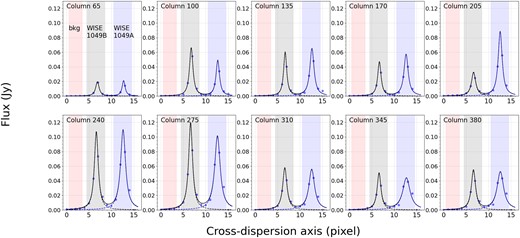2024-07-15 エディンバラ大学
<関連情報>
- https://www.ed.ac.uk/news/2024/scorching-storms-on-distant-worlds-revealed-in-new
- https://academic.oup.com/mnras/article/532/2/2207/7712857?login=false
褐色矮星に最も近いJWSTの天気予報I:ベンチマーク連星褐色矮星WISE 1049ABの多周期JWST NIRSpec + MIRI観測 The JWST weather report from the nearest brown dwarfs I: multiperiod JWST NIRSpec + MIRI monitoring of the benchmark binary brown dwarf WISE 1049AB
Beth A Biller, Johanna M Vos, Yifan Zhou, Allison M McCarthy, Xianyu Tan, Ian J M Crossfield, Niall Whiteford, Genaro Suarez, Jacqueline Faherty, Elena Manjavacas …
Monthly Notices of the Royal Astronomical Society Published:15 July 2024
DOI:https://doi.org/10.1093/mnras/stae1602

ABSTRACT
We report results from 8 h of JWST/MIRI low resolution spectroscopic (LRS) monitoring directly followed by 7 h of JWST/NIRSpec prism spectroscopic monitoring of the benchmark binary brown dwarf WISE 1049AB, the closest, brightest brown dwarfs known. We find water, methane, and CO absorption features in both components, including the 3.3 μm methane absorption feature and a tentative detection of small grain (< 1μm) silicate absorption at >8.5 μm in WISE 1049A. Both components vary significantly (>1 per cent), with WISE 1049B displaying larger variations than WISE 1049A. Using K-means clustering, we find three main transition points in wavelength for both components of the binary: (1) change in behaviour at ∼2.3 μm coincident with a CO absorption bandhead, (2) change in behaviour at 4.2 μm, close to the CO fundamental band at > 4.4 µm, and (3) change in behaviour at 8.3–8.5 µm, potentially corresponding to silicate absorption. We interpret the light curves observed with both NIRSpec and MIRI as likely stemming from (1) a deep pressure level driving the double-peaked variability seen in WISE 1049B at wavelengths <2.3 and >8.5 µm, (2) an intermediate pressure level shaping the light-curve morphology between 2.3 and 4.2 µm, and (3) a higher altitude pressure level producing single-peaked and plateaued light-curve behaviour between 4.2 and 8.5 µm.


